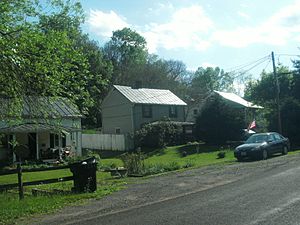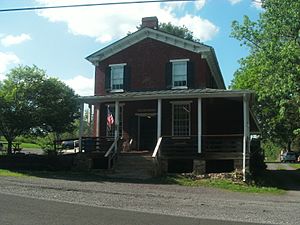Laurel Mills, Virginia facts for kids
Quick facts for kids
Laurel Mills
|
|
|---|---|

Houses in Laurel Mills, May, 2016
|
|
| Country | United States |
| State | Virginia |
| County | Rappahannock |
| Time zone | UTC-5 (Eastern (EST)) |
| • Summer (DST) | UTC-4 (EDT) |
| ZIP code |
22716
|
| Area code(s) | 540 |
|
Laurel Mills Historic District
|
|
| Location | Roughly bounded by Laurel Mills Rd., Thornton R. & Laurel Mills Farm, Laurel Mills, Virginia |
| Area | 56.3 acres (22.8 ha) |
| Built | 1847 |
| Architect | Hawkins, George W.; Wood, A.N. & Son |
| Architectural style | Late Victorian, Late 19th And Early 20th Century American Movements |
| NRHP reference No. | 04001273 |
| Significant dates | |
| Added to NRHP | November 27, 2004 |
Laurel Mills is a small, historic community in Rappahannock County, Virginia, in the United States. It's not a city or town, but an "unincorporated community," meaning it doesn't have its own local government. You can find it in the southern part of the county, nestled along the Thornton River.
This charming area is located on Route 618, known as Laurel Mills Road. It sits between the communities of Viewtown and Rock Mills. Laurel Mills is also about halfway between the larger towns of Amissville and Washington.
Contents
What is Laurel Mills Known For?
Laurel Mills is famous for its rich history, especially its old mills and unique buildings. Many of these structures date back to the 1800s. The community looks much like it did when its main mill closed almost a century ago.
Early History and Mills
Long ago, even before the American Revolution, Laurel Mills was a busy place. It had a sawmill, which cut wood, and a gristmill, which ground grain into flour. The sawmill was called Baker's Mill, and the gristmill was known as Roberts' Mill.
A man named William Roberts, or perhaps his father John Roberts, might have owned Roberts' Mill. These mills were very important for the people living in the area. They helped process local resources.
The First Post Office
In 1847, Laurel Mills got its own post office. This made it easier for people to send and receive letters. Cornelius Smith was the first postmaster. Before this, a post office might have been at a nearby spot called Newby's Crossroads.
Exploring Laurel Mills' Architecture
Laurel Mills is like a living museum of old buildings. Many structures here were built in the mid-to-late 1800s. They show off different styles of architecture from that time.
Architectural Styles You Can See
You can spot buildings designed in several cool styles:
- Greek Revival: This style looks like ancient Greek temples.
- Queen Anne: These homes often have turrets, towers, and decorative details.
- Italianate: Buildings in this style might have low-pitched roofs and tall, narrow windows.
- Gothic Revival: This style often features pointed arches and steep roofs.
Homes and the Old Store
There are three workers' houses from around 1840. They are simple, wood-framed homes with stone foundations. These houses show how people lived and worked in the past.
The ruins of the Rappahannock Woolen Mills Company are also here. These ruins are examples of early 20th-century factory buildings. An old, red general store still serves the community today. It sells groceries, other items, and even fuel.
The mill owner's large house sits on a bluff, looking down over the village. This old mansion has a turret and wide porches. Today, it's a bed and breakfast where visitors can stay.
The Thornton River's Importance
The Thornton River was key to Laurel Mills' success. The river's flowing water provided power for the mills. This natural energy source helped the mills operate and produce goods. The village was built to take advantage of the river's power.
Laurel Hill Mansion
Across the Thornton River, on a hill, once stood a grand mansion called "Laurel Hill." Major John Roberts, a hero from the Revolutionary War, built this home in the early 1800s. His family owned a lot of land in the area.
The Roberts family lived at "Laurel Hill" until about 1850. Sadly, the mansion burned down in 1915. This happened because of a problem with a chimney in a new kitchen that had been added to the house.
Laurel Mills Historic District
Because of its unique history and well-preserved buildings, Laurel Mills is recognized as a special place. The Laurel Mills Historic District includes the remains of the mill and other important structures. In 2004, this district was added to the National Register of Historic Places. This means it's officially recognized for its historical importance in the United States.




